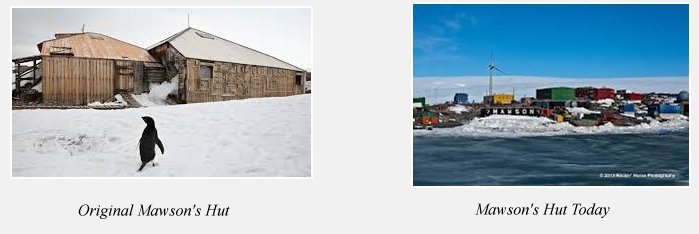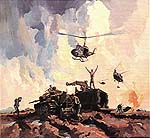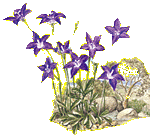Unusual Service Story of
A33685 WO John (Snow) Williams RAAF
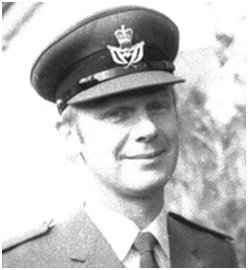
I left Brighton Technical School at 14 for a job with the Melbourne Harbour Trust as a messenger boy. This meant travelling on a bicycle around the city, North Wharf and Victoria Dock. I must have been fit as I usually cycled the 10 miles (16 Kilometres) from home in East Brighton as well. I enjoyed that time, seeing all those wonderful, beautiful old ships and gaining a world of experience.
However, promises of training as a draughtsman did not eventuate. So the Airforce beckoned. Maybe this was due to my father enjoying his five years at Point Cook in the 1920s and his 24 years of military service in WW1 in Europe & WW2 in Australia. Little did I know that I would work for both these services for 24 years and, coincidentally, I spent 24 years on the farm after my Air Force years, and, I was 24 when I first went to the Antarctic.
It seemed normal at first- three years apprenticeship training at Wagga Wagga as an airframe fitter covered all sorts of seemingly unrelated subjects- such as basic electrics, optics, engines, magnetos, blacksmithing, welding and more. However, either in the Air Force or during my 2 years of secondment to work in the Antarctic, I used some aspect of all those subjects. I was especially grateful for all that training when 5 years after leaving Wagga I was 'thrown in at the deep end' during my first Antarctic sojourn.
I was on the fourth intake of engineering apprentices starting on 25 January 1950. I started behind the eight ball being only 4 foot 11 inches tall- 1 inch too short for the service but I managed to convince the Airforce doctor, on my medical exam, that, as my father was 6 feet tall I was going to grow. And that I did- shooting up to my present weight and 5 foot 10 inches on 3 years of good Air Force rations.
About the food, it was plentiful except for eggs and butter and we tried all sorts of things to get an extra egg. Just imagine my delight when on a Saturday mess duty, due to many apprentices sleeping in, there was a tray of 17 eggs and half a tray of bacon left over-. Not being one to waste things I demolished the lot and, there were no explosive after effects. Regarding food; butter was issued at the rate of one fortieth of a pound of butter per meal; not much for 2 slices of toast. Rationing was still in place from the war years and on home leave we were issued with ration coupons for tea and butter that were very much appreciated at home.
The time at Wagga was fairly interesting; after school time a group of us convinced the Airforce to provide all the materials and a supervisor to build a primary glider which was almost finished when we bought a crashed 2 seat Merlin sailplane. We then transferred our energies to that, got it flying and I think we all had a flight before it crashed off the towline at the old wartime airfield at Uranquinty that was just being reopened. Once again the Airforce was good to us as they provided a test pilot, a van, and a Weapon Carrier with driver, for towing. We had a great time there at weekends over a month or so.
By this time our 3 years at Wagga were up and we all dispersed to postings around Australia. After Wagga the usual Aircraft Depot 6 month spell, gaining experience was spent at 1AD Laverton on different aircraft types and in hydraulic and pneumatic sections. Then it was on to Maintenance Squadron Point Cook servicing and overhauling their Tiger Moths and Wirraways. Here, incidentally, I was getting up many hours in the back seat writing down the test pilots remarks, sometimes with some difficulty as some pilots were freshly back from the Korean war and they would practice their dog fighting skills, often low down among the isolated gum trees near the You Yang Ranges.
After a couple of years, and, to my dismay as I wanted a more adventurous operational squadron posting, I was posted to Maintenance Squadron East Sale to work on more of the same but also Winjeels, Mustangs, Lincolns, Dakotas and Vampires. From E Sale by a stroke of luck as it turned out; I went back to 1AD and Canberra bombers.
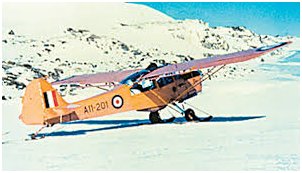 Now; for the last couple of years I had applied to go to the Antarctic and had been selected as the reserve airframe fitter. So, when in late 1958 the old Antarctic Auster (Pictured) came in pieces into the hangar to be overhauled for a special trip south to take over the US base of Wilkes, on the Antarctic coast, I lobbied to be the corporal in charge. I got the job, and one day the pilot, Squadron Leader Doug Leckie came to check progress. We met and I was selected to go south with him.
Now; for the last couple of years I had applied to go to the Antarctic and had been selected as the reserve airframe fitter. So, when in late 1958 the old Antarctic Auster (Pictured) came in pieces into the hangar to be overhauled for a special trip south to take over the US base of Wilkes, on the Antarctic coast, I lobbied to be the corporal in charge. I got the job, and one day the pilot, Squadron Leader Doug Leckie came to check progress. We met and I was selected to go south with him.
After test flights on wheels at Laverton and on floats atPoint Cook. [Where a slight problem occurred due to incorrectly supplied measurements - the float top was punctured on take off]. After repairs, adjustments and another test flight the Auster was trucked to North Wharf on the Yarra River in Melbourne and loaded on top of Number Two Hold of the icebreaker Magga Dan.
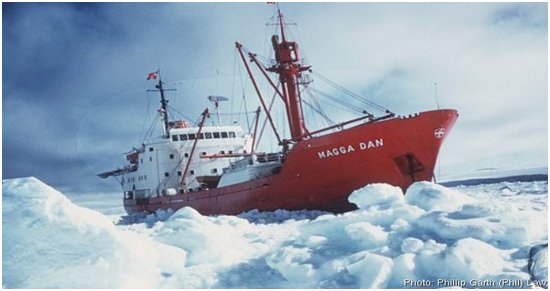
It was one of those hot 100 degree days - no foretaste of the temperatures to very soon come to us. We rolled our way south on this Danish ship sharing a luxurious cabin with Sqdn Leader Doug Leckie, (pictured below) a Navy Lt Commander- Ian Burnside, Engine fitter, Corporal Nev Meredith and myself; In Ian’s eyes our only misdemeanour was to use non nautical terms when referring to the ships parts! En route we serviced an automatic weather station at Lewis Island, a tiny speck of rock beside the ice cliffs of the continent, here Doug took the Auster up for a sea ice check to plot our way further west toward Wilkes. We then sailed west to Dumont d’Urville,(Pictured) the French base where, after a stormy, rough Army DUKW trip ashore we were royally entertained; strangely, the wines were Australian and ours on the ship were French.
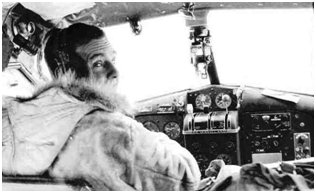 On westward again, we sailed inside the pack ice belt for a few days where the sea was very calm and enjoyable. So, we travelled on to Wilkes Base where a group of 26 Americans were waiting to hand over the station. The station was an eye opener; as it was the last station built by the US for the IGY (International Geophysical Year) two years before and all left over food, fuel and equipment including a large building full of beer from the building of three stations was left at Wilkes. (pictured)
On westward again, we sailed inside the pack ice belt for a few days where the sea was very calm and enjoyable. So, we travelled on to Wilkes Base where a group of 26 Americans were waiting to hand over the station. The station was an eye opener; as it was the last station built by the US for the IGY (International Geophysical Year) two years before and all left over food, fuel and equipment including a large building full of beer from the building of three stations was left at Wilkes. (pictured)
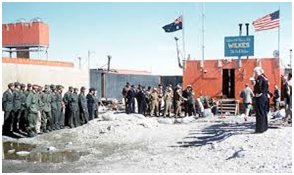
Doug did a lot of flying there on skis over the change over period- one day he was in the air for over 9 hours and we only had a couple of under carriage mishaps that were soon fixed. Soon it was time for the ship to sail. We pontooned the Auster out to the ship, where I rigged the aircraft back onto floats.
Then at 10am I was called to Phillip Law's [The Director] cabin where I was asked if I would like to stay the year at the Station as third engineer because the base crew were short handed. Australia had replaced eight (8) US maintenance personnel with two (2) people. I jumped at the opportunity and left it to him to sort it out with the Air Force.
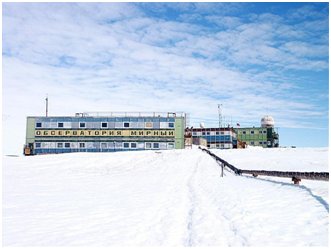 For my first three months I was the carpenter and plumber, then, the second engineer had a serious break down, and had to be physically restrained, and, locked up for 10 months until he could be repatriated to Australia, flying by Neptune via McMurdo and New Zealand. The Russians flew a Russian made DC3 over from their base at Mirny (pictured) with their Doctor, Commissar, and 7 others and some extra drugs. Our Doctor was apprehensive about the visit as he had recently escaped from Hungary. But all went well and we socialised readily; that was during the cold war years of course.
For my first three months I was the carpenter and plumber, then, the second engineer had a serious break down, and had to be physically restrained, and, locked up for 10 months until he could be repatriated to Australia, flying by Neptune via McMurdo and New Zealand. The Russians flew a Russian made DC3 over from their base at Mirny (pictured) with their Doctor, Commissar, and 7 others and some extra drugs. Our Doctor was apprehensive about the visit as he had recently escaped from Hungary. But all went well and we socialised readily; that was during the cold war years of course.
I then became second engineer for three months, until the chief engineer was accidentally killed. As senior diesel mechanic I then had everything to look after- trucks, bulldozers, over snow tracked vehicles, fixed plant, 3 phase electricity supply, water and fuel supply and explosives, the US had let behind many tons of explosives. [I survived an Army course and became qualified to handle service explosives for my second trip south - after much experience on the first trip]
Scariest of all to me was the power supply through not being confident with 3 phase power; however, with help from the rest of our crew, in particular Alby the Cook who became the Assistant Diesel Mechanic the station functioned well without a power breakdown for the rest of our year.
Too soon for me the year was up, as even with our problems and about 9 months of weekly, severe blizzards, that lasted for many days at a time I still liked the way of life.
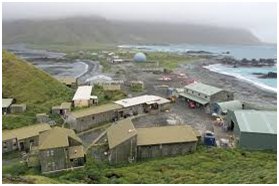 We sailed for Melbourne via sub Antarctic Macquarie Island (Pictured) where landing through the surf by Army DUKW was quite an experience. In the one day there we were able to explore and see our first greenery and many different kinds of wildlife; but, best of all was the lunch with fresh hothouse grown salad Fresh lettuce, spring onions and radishes with tops, will always remind me of that lunch.
We sailed for Melbourne via sub Antarctic Macquarie Island (Pictured) where landing through the surf by Army DUKW was quite an experience. In the one day there we were able to explore and see our first greenery and many different kinds of wildlife; but, best of all was the lunch with fresh hothouse grown salad Fresh lettuce, spring onions and radishes with tops, will always remind me of that lunch.
Six weeks leave and it was back to the Airforce at Aircraft Research and Development Unit At Laverton. As well as working on the usual aircraft there, I became partly qualified on a very unusual jet plane- the Avro 707A delta wing research aircraft. After some time there I was posted to 86 Wing and the Hercules transports at Richmond. I was a bit bored there at first and applied to go south again as a Diesel Mechanic.
The Antarctic Division was keen for me to go as Senior Diesel Mechanic but I asked to be assistant as I thought that my experience was limited. Before I left the Hercules, the workload increased as the first fuel tank problems were found and I was in there helping to deal with the big job of treatment and repairs. A few years later that experience helped me to deal with an isolated Sabre corrosion problem in Malaysia.
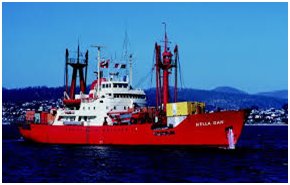 And so; soon, in mid 1961 I was back in Melbourne again for a few months indoctrination before sailing on the Nella Dan (pictured) for Mawson. The ship sailed via the small station of Davis on the coast of the Vestfold Hills, Antarctica, where we poured concrete and helped install a new generating set into the power house.
And so; soon, in mid 1961 I was back in Melbourne again for a few months indoctrination before sailing on the Nella Dan (pictured) for Mawson. The ship sailed via the small station of Davis on the coast of the Vestfold Hills, Antarctica, where we poured concrete and helped install a new generating set into the power house.
This time the Airforce insisted that I be paid at Airforce rates of pay and allowances- previously, Phillip Law, Antarctic Division Director, unbeknown to me, had fought long and hard to pay me the slightly higher civilian rates - contrary to Queen's Regulations. The second tour, compared to the first stressful one was wonderful, with me doing lots of trips as mechanic; on the sea ice assisting with surveying and biological surveys; and on the continental plateau around the mountains nearby. One inland trip was in Autumn to place a fuel and food depot over 100 miles inland at over five thousand feet altitude; the days were getting shorter and colder, in fact at over minus thirty degrees in wind and drifting snow our worst breakdowns occurred, first the non repairable Weasel track broke and was oxy cut, steel rivets drilled out and a section of chain linked track joined in.
 However, while trying to start next day the Weasels distributor stopped turning. I told the officer in charge that even with the almost nil oxygen and acetylene pressures I thought that over a week I could braze parts back together but I would not guarantee the fix. We then left the Weasel (pictured below) there to be towed back on our returning after establishing the final depot.
However, while trying to start next day the Weasels distributor stopped turning. I told the officer in charge that even with the almost nil oxygen and acetylene pressures I thought that over a week I could braze parts back together but I would not guarantee the fix. We then left the Weasel (pictured below) there to be towed back on our returning after establishing the final depot.
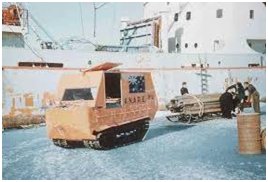 Some days on the trip it took over 7 hours to break camp, heating vehicles, shovelling the hard packed overnight build up of snow, and freeing the eight sledges our two bulldozers were towing. The final depot was established at an altitude of over fifteen hundred metres some distance before the projected site as we struck several days of nil visibility blizzards and, we did not want to spend winter out there. The return to camp was a little easier as we had some of the tracks still visible and the weather was kinder.
Some days on the trip it took over 7 hours to break camp, heating vehicles, shovelling the hard packed overnight build up of snow, and freeing the eight sledges our two bulldozers were towing. The final depot was established at an altitude of over fifteen hundred metres some distance before the projected site as we struck several days of nil visibility blizzards and, we did not want to spend winter out there. The return to camp was a little easier as we had some of the tracks still visible and the weather was kinder.
Here too at Mawson, we had Russian visitors- the icebreaker Ob landing Russian aircraft fuel and 2 lots of aircraft passing through to the west; Antonov biplanes and something like a Convair; we enjoyed the friendly socialising over several days. They had a secret weapon that helped break the ice, they called it aero whisky and it was dangerous stuff as it was actually Dakota de icing fluid. There was one hiccup on their last flight when our only available vehicle broke a track and we all had to walk the 16 kilometres back to camp starting at midnight. We had towed two sleds with mattresses tied on to carry the large party back to base.
The rolling trip back by the Nella Dan was interesting as we called into the old ANARE station on Heard Island then to the French base on Kerguelen Island (picture below).
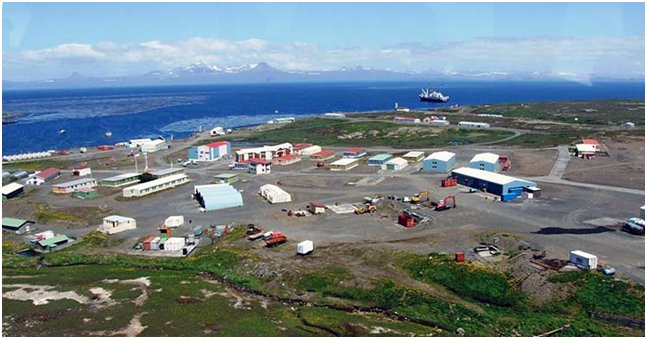
Here I was able to go inland by Weasel and help our Lichenologist and our Doctor collect lichens and other samples. It was a very interesting expedition as the Weasel almost sunk at one stage into a bog, and, it was the first time for me to have a French lunch of baguettes, cheese and red wine decanted from a 4 gallon jerry can. The evening celebration only got better, I remember a talented Frenchman dancing and singing on the table and their priest trying to get us all to freely imbibe.
The sail back to Hobart was memorable as we were running with the wind and there were massive swells we were climbing and sinking down into. During my Antarctic years I collected a Polar medal, 2 service Medallions, a mountain in my name that I have not seen, and a group of tiny islets called Williams Rocks about 15 km off the Mawson coast that I helped survey. We travelled over the sea ice to them by Snow Track and my motor cycle outfit. On the way out, Dave the surveyor and I may have been the first to drive a motor cycle up on top and around on a grounded iceberg. Also I found the first Acrospora Williamsii lichen ever found and our Lichenoligist named it as such!
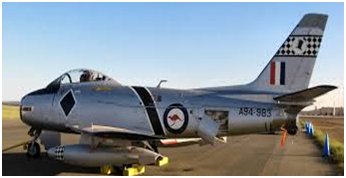 After 6 weeks leave on return, I was posted first to Point Cook with Sergeants stripes then to Malaya to 86 Wing and Sabre fighter jets. (Pictured) Getting there was by a luxury cruise on MV Fairstar from Melbourne to Singapore, which incidentally was having a period of unrest and I was one of the few allowed off the ship. At Butterworth, I, not having been through Williamtown and Sabre training had some study to do to catch up on and while there I was usually in Maintenance Squadron snag gang. After a few months I was posted to 79 Squadron, Ubon, Thailand, where we had 8 hot Sabres for the defence of Thailand.
After 6 weeks leave on return, I was posted first to Point Cook with Sergeants stripes then to Malaya to 86 Wing and Sabre fighter jets. (Pictured) Getting there was by a luxury cruise on MV Fairstar from Melbourne to Singapore, which incidentally was having a period of unrest and I was one of the few allowed off the ship. At Butterworth, I, not having been through Williamtown and Sabre training had some study to do to catch up on and while there I was usually in Maintenance Squadron snag gang. After a few months I was posted to 79 Squadron, Ubon, Thailand, where we had 8 hot Sabres for the defence of Thailand.
To me that was a wonderful place, we all had a great feeling of camaraderie and the locals were friendly. The postings there were only for 8 weeks at a time; however, I managed to extend a few times and finished up doing about 12 months- half of my time served in that tropical tour. A stroke of luck happened there when I was made a ‘Specially Approved’ driver to help drive an armed convoy of 3 new trucks from Bangkok to Ubon. It turned into a 3 day journey through supposedly bandit infested country over a lot of rough unsealed
roads. On another Ubon posting I had to help return a Jeep from Khorat back over much of the same route and, again, back in Malaysia I was selected to drive a staff car from Singapore back to Butterworth. To have one of those licences was, in my times a very desirable license to have as it could lead to some adventures.
Not long before returning to Australia a badly corroded Sabre (Pictured) came in for repairs- I told my bosses of my previous corrosion work and I was put in charge of a job that would otherwise have had to be returned to Australia for repairs. I think that I must have received a good report from that as, when I returned to Australia on posting to Maintenance Squadron East Sale, I was promoted to Flight Sergeant.
That brought with it a posting into Headquarters Support Command [HQSC] for technical spares assessing duties. Just before I left E Sale though I had my only charge in RAAF service - a serious technical one and I was found guilty. But, due to mitigating circumstances I only received an admonishment; and six months later I was in Switzerland as a temporary Warrant Officer Airframe Fitter! I was doubtful about having a desk job but came to like it- my boss there was Wing Commander Avro Anson an old friend initially from Point Cook where he was a Warrant Officer pilot, then 1AD from where I left for the Antarctic in 1959.
 I had been in Victoria Barracks only perhaps 5 months when he offered me the job of going to Switzerland to assess spares for the Army's Pilatus Porter aircraft.(pictured) My qualifications apparently were that I was not too much into the Airforce stores system and I had to think outside the box and develop a simple, early days of computers, parts listing system using punch cards. And so the rush started-. I met Warrant Officer Blue Buchanan, an Army Motor Mechanic from the Army Cataloguing Department at Albert Park Barracks. We were told to be ready to go in 6 weeks and to try to learn some German. The RAAF School of Languages helped with a couple of tapes but learning was slow! In the event it was more like 3 months before we left. There was a problem with travel as Blue was a Warrant Officer and in those days he was entitled to first class travel. So that we could travel together the solution was to temporarily promote me! And so I became probably, the only Warrant Officer Airframe Fitter in the Airforce - about 8 months after my last promotion.
I had been in Victoria Barracks only perhaps 5 months when he offered me the job of going to Switzerland to assess spares for the Army's Pilatus Porter aircraft.(pictured) My qualifications apparently were that I was not too much into the Airforce stores system and I had to think outside the box and develop a simple, early days of computers, parts listing system using punch cards. And so the rush started-. I met Warrant Officer Blue Buchanan, an Army Motor Mechanic from the Army Cataloguing Department at Albert Park Barracks. We were told to be ready to go in 6 weeks and to try to learn some German. The RAAF School of Languages helped with a couple of tapes but learning was slow! In the event it was more like 3 months before we left. There was a problem with travel as Blue was a Warrant Officer and in those days he was entitled to first class travel. So that we could travel together the solution was to temporarily promote me! And so I became probably, the only Warrant Officer Airframe Fitter in the Airforce - about 8 months after my last promotion.
The job overseas entailed travel inside Switzerland, to Paris regularly, and once to the U.K. It was interesting but work at the factory was slowed by their primitive listing and parts numbering systems which were in the throes of converting to computer listings. From the expected 4 months it carried on for 10 months and then it was back to HQSC - where I reverted to Flight Sergeant for a couple of years until a fairly early promotion to Warrant Officer Engineer, 20 years after a boy joined the RAAF Apprentice scheme. We were given staff of 1 civilian clerk, 1 Corporal equipment and 1 Army Private. Together we listed spares, assessed requirements, wrote instructions for use, had listings printed, published, bound and Blue and I delivered the initial copies to Army units as needed. We had to liaise between the services, civilian departments and nicely apply some pressure to get the job done as quickly as possible. All of the paperwork was done to our simple computer listing system for Army use. Then 6 years went by and Government instructions were to conform to the one universal system- as this happened I realised that I had had a good, unusual life and it was time to move on.
I was discharged in January 1974, 24 years after joining up at Wagga Wagga and I then started on a new set of adventures. Those included world travel, driving across the USA to Alaska where I canoed some wild rivers, caught Salmon and found a small amount of gold, then marriage, 24 years as a farmer in New Zealand back country with our 4 children on correspondence schooling- the eldest Catherine is now a cruise ship Captain and the others are doing well - and travelling!
